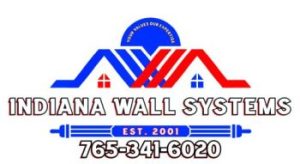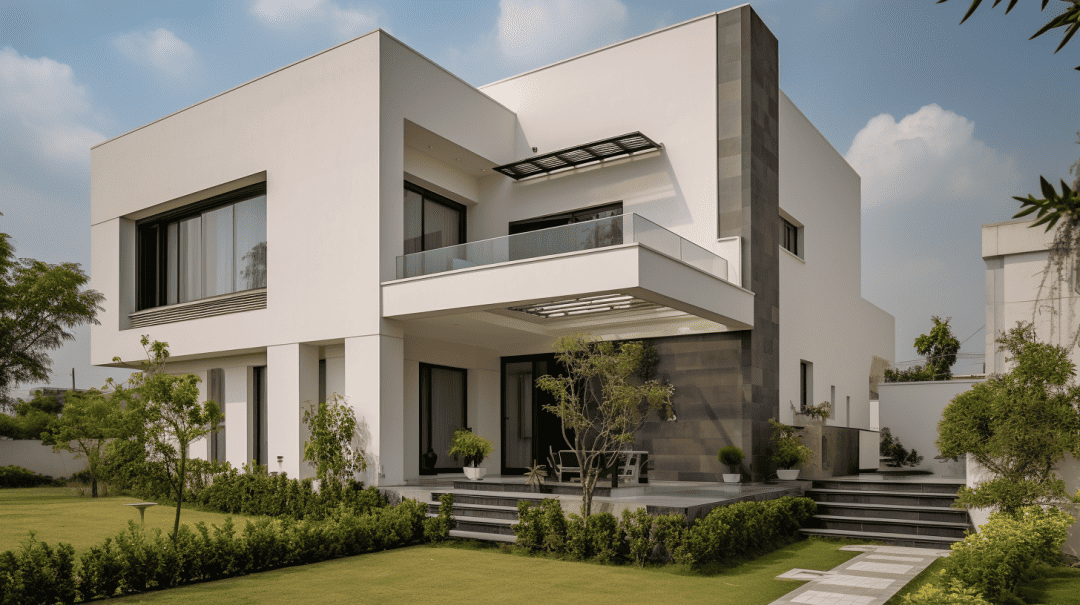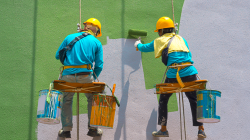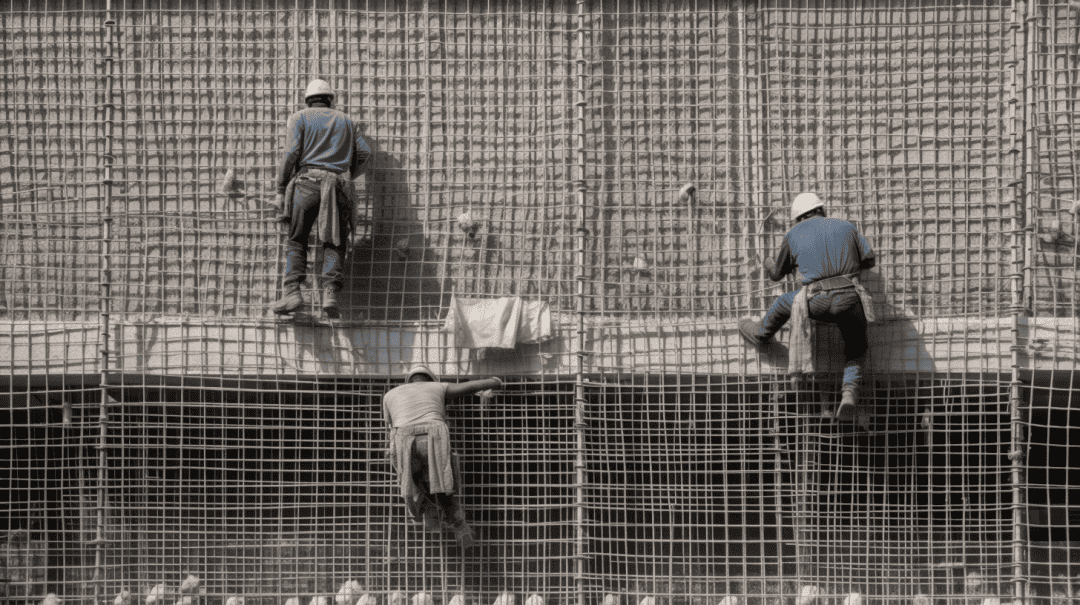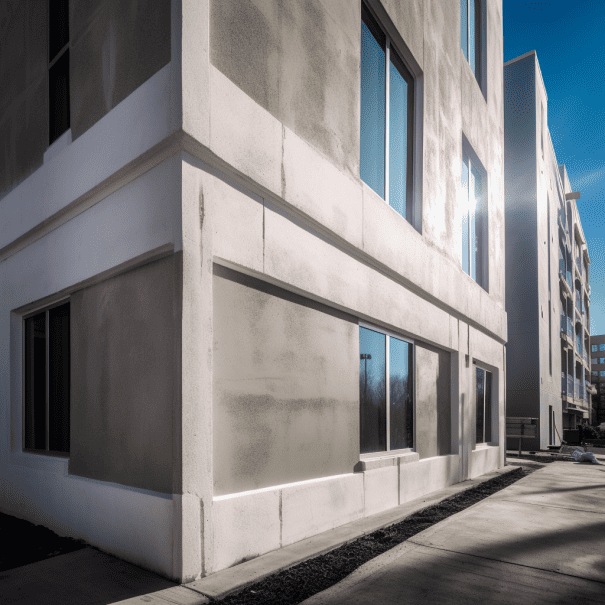Tired of Your Home’s Boring Exterior? Here’s What You Need to Know About Wall Finish Options
Updated on November 10, 2025.
Your home’s exterior is the first thing people notice. If your walls look tired, outdated, or just plain boring, you’re probably ready for a change. The Good News? You have more options than you think. And one of the best choices is EIFS (Exterior Insulation and Finish System).
EIFS gives you tons of design flexibility, serious energy savings, and protection that lasts. Whether you’re creating a new exterior or revitalizing an existing one, knowing your wall finish options empowers you to make informed decisions that are both cost-effective and visually stunning.
We’ll explore the various types of exterior wall finishes currently available and discover why EIFS continues to be the preferred choice among homeowners and builders throughout Central Indiana.
Key Takeaways
- EIFS offers superior insulation and can reduce energy costs by up to 30% compared to traditional wall systems
- Modern EIFS systems include water-managed drainage that handles moisture better than older barrier-style systems
- EIFS provides more design flexibility than traditional stucco, masonry, or wood siding with customizable textures and colors
- Proper maintenance extends EIFS lifespan to 30-50 years with bi-annual inspections and cleaning as needed
- Acrylic and silicone finishes offer the best durability and weather resistance for Indiana’s climate
Why EIFS Outperforms Traditional Wall Finishes
Energy Savings
Up to 30% reduction in heating and cooling costs compared to traditional systems
Longevity
Lasts 30-50 years with proper maintenance and bi-annual inspections
Design Freedom
Unlimited texture, color, and finish options for any architectural style
Moisture Control
Modern water-managed systems handle Indiana’s freeze-thaw cycles perfectly
🔥 22+ Years of EIFS Expertise Serving Central Indiana
From 300,000 sq ft commercial projects to residential repairs
What Makes a Good Exterior Wall Finish?
Before we get into specific materials, let’s talk about what matters most in an exterior wall finish.
A quality wall finish should do three things:
- Protect your building from weather, moisture, and impact damage
- Insulate effectively to reduce energy bills year-round
- Look great and match your home’s style
Durability, maintenance requirements, and energy efficiency separate okay finishes from great ones.
You also want something that fits your budget without cutting corners on quality.
Exterior Wall Finishes: Quick Comparison
| Material | Cost/Sq Ft | Lifespan | Insulation | Maintenance |
|---|---|---|---|---|
| EIFS ⭐ | $8-14 | 30-50 yrs | Excellent | Low |
| Vinyl Siding | $3-7 | 20-30 yrs | Poor | Low |
| Fiber Cement | $10-15 | 30-50 yrs | Poor | Moderate |
| Traditional Stucco | $9-16 | 50-80 yrs | Poor | High |
| Brick Veneer | $15-30 | 100+ yrs | Poor | Moderate |
| Natural Stone | $25-50+ | 100+ yrs | Poor | Low |
Key Insight: EIFS offers the best balance of cost, performance, and energy efficiency for Indiana’s climate. Only EIFS provides built-in continuous insulation with design flexibility.
That’s where EIFS shines. It checks all these boxes and then some.
Understanding EIFS (Exterior Insulation and Finish System)
EIFS is a multi-layer wall system that combines insulation with a durable, attractive finish. It’s been used in Europe since the 1950s and came to North America in the 1970s.
Here’s what makes up a typical EIFS system:
- Insulation board (usually expanded polystyrene foam) attached to the wall substrate
- Base coat embedded with reinforcing mesh for strength and impact resistance
- Finish coat in your choice of color and texture
Modern EIFS systems include water-managed drainage planes that handle moisture better than older barrier-style systems. This upgrade addressed earlier concerns and made EIFS even more reliable for all climates—including Indiana’s freeze-thaw cycles.
According to industry research, EIFS can cut energy costs by up to 30% compared to traditional wall systems. That’s real money back in your pocket every month.
The continuous insulation layer effectively prevents thermal bridging, ensuring that heat does not escape through studs or framing members as it typically does in conventional construction.
For more details on how EIFS works, check out our guide on synthetic stucco and EIFS explained.
Traditional Stucco Wall Finishes
Traditional stucco has been around for centuries. It’s made from cement, sand, lime, and water—applied in multiple coats over metal lath.
Stucco is heavy and goes directly onto the structure. Unlike EIFS, it doesn’t include built-in insulation.
Common stucco finish textures include:
- Smooth finish – Clean and modern looking, but shows imperfections easily
- Sand finish – Fine, grainy texture that’s popular for residential homes
- Dash finish – Rougher with small raised bumps, hides minor flaws well
- Cat face finish – Irregular smooth patches in rough texture for rustic appeal
Stucco works well in dry climates. But in places like Indiana with high humidity and freeze-thaw cycles, it can crack over time.
Water gets into those cracks. Then it freezes and expands. This creates bigger cracks and potential structural problems.
Traditional stucco also needs more maintenance than EIFS. Cracks require repair to prevent water infiltration. And repainting every 5-7 years keeps it looking fresh.
Want to know more about the differences? Read our comparison of stucco vs. EIFS.
Masonry Wall Finishes (Brick and Stone)
Brick and stone are timeless choices. They’ve protected buildings for thousands of years.
Brick veneer and natural stone offer excellent durability. They resist fire, wind, and impact damage better than most other materials.
But masonry comes with downsides:
- Heavy weight requires strong structural support and deep footings
- High cost for materials and skilled labor installation
- Poor insulation without additional insulation layers added inside
- Limited design flexibility compared to EIFS or stucco
Brick and stone also require regular mortar joint maintenance. Joints deteriorate over time and need repointing every 20-30 years.
Many homeowners love the look of brick or stone but can’t afford the full cost. That’s why EIFS with a faux stone or brick finish became popular. You get the look without the weight or expense.
Indiana Wall Systems specializes in brick restoration and tuck-pointing for existing masonry that needs repair.
Wood Siding Finishes
Wood siding brings natural warmth and texture to any home. Options include clapboard, shingles, board-and-batten, and tongue-and-groove.
Wood can be stained to show off the grain or painted for more color choices.
But wood requires serious upkeep:
- Regular painting or staining every 3-7 years depending on exposure
- Susceptible to rot if moisture gets trapped behind the siding
- Termite and pest problems in many regions including Indiana
- Warping and splitting from temperature and humidity changes
Wood siding also offers minimal insulation value. You need separate insulation inside the walls.
Some newer engineered wood products resist rot better than natural wood. But they still need regular maintenance and eventual replacement.
For homeowners who want the wood look without the hassle, EIFS can mimic wood grain textures. You get the aesthetic appeal with far less maintenance.
Fiber Cement Wall Finishes
Fiber cement siding became popular in the 1980s as a low-maintenance alternative to wood.
It’s made from cement, sand, and cellulose fibers. The result is a durable, fire-resistant product that resists rot and termites.
Popular fiber cement brands include:
- HardiePlank – Industry leader with 30-year warranties
- Allura – Offers realistic wood grain textures
- Nichiha – Wide range of colors and panel styles
- CertainTeed – Known for color retention
Fiber cement resists moisture damage better than wood. It won’t rot, warp, or attract pests.
But it has limitations:
- Heavy weight makes installation labor-intensive
- Requires painting every 10-15 years unless you buy pre-finished
- Can crack if not installed properly with proper expansion gaps
- Limited insulation value without adding separate insulation
Fiber cement costs more upfront than vinyl siding but less than brick or stone. Studies show it offers good return on investment when you sell your home.
Vinyl Siding
Vinyl siding dominates the residential market because of its low cost and easy maintenance.
It’s made from PVC plastic formed into panels that snap together. No painting or staining required.
Vinyl’s advantages:
- Lowest upfront cost of most siding options
- No painting needed – color goes through the material
- Easy to clean with just soap and water
- Resists insects and rot
But vinyl has drawbacks too:
- Poor insulation – just a thin shell over your walls
- Cracks in cold weather and can become brittle over time
- Fades in direct sunlight especially darker colors
- Can melt or warp from nearby heat sources or reflected sunlight
- Looks cheap compared to other options
Vinyl siding doesn’t offer the curb appeal or energy efficiency of EIFS. And while it’s inexpensive initially, it may need replacement sooner than other materials.
For a detailed comparison, see our article on EIFS vs. vinyl siding for Indiana homes.
Metal Siding and Panels
Metal siding includes aluminum, steel, and zinc panels. It’s most common on commercial buildings but some modern homes use it too.
Metal offers excellent durability and fire resistance. It won’t rot, warp, or attract pests.
But metal siding has issues:
- Dents easily from hail or impact
- Can rust or corrode if protective coating is damaged
- Conducts heat and cold requiring extra insulation
- Limited residential appeal – looks too commercial for many tastes
Standing seam metal roofs are popular, but metal wall siding remains a niche choice for homes.
EIFS Finishes and Textures
Now let’s dive deeper into EIFS options. This is where things get interesting.
EIFS offers more design flexibility than any other wall finish system. You can create almost any look you want from smooth modern to heavily textured rustic.
The finish coat determines your final appearance. And you have dozens of choices.
Smooth Finishes
Smooth EIFS finishes give you a sleek, modern look. Think of a gallery wall or contemporary museum.
The smooth surface reflects light evenly. This creates clean lines and shows off architectural details.
Smooth finishes work great for:
- Modern and contemporary homes
- Commercial buildings that want a professional appearance
- Accent walls or features that need to stand out
Smooth finishes are also easier to clean than heavily textured ones. A simple rinse removes most dirt and debris.
But they show imperfections more easily. Any dent, scratch, or substrate irregularity will be visible. That’s why proper installation is critical.
Fine Sand Finishes
Fine sand finishes are the most popular EIFS texture. They look like fine sandpaper or beach sand.
This texture hides minor imperfections better than smooth finishes. It still looks refined and works with most architectural styles.
Fine sand finishes are perfect for:
- Traditional residential homes
- Mediterranean or Spanish-style architecture
- Buildings that need a classic, timeless look
The subtle texture adds visual interest without being too busy. It photographs well and maintains curb appeal for decades.
Coarse Sand and Dash Finishes
Coarse textures create more pronounced surface variation. Think of rough-hewn stone or rustic plaster.
Dash finishes have small raised bumps across the surface. Heavy dash creates even more texture with larger aggregate particles visible.
These finishes work well for:
- Rustic or craftsman-style homes
- Buildings in natural settings where a rough texture fits the environment
- Hiding substrate imperfections or covering less-than-perfect walls
Coarse textures also hide dirt and weathering better than smooth finishes. But they’re harder to clean thoroughly.
Specialty and Custom Finishes
This is where EIFS really shines. You can create custom looks that would be impossible with other materials.
Options include:
- Faux stone or brick – Looks like natural materials at a fraction of the cost and weight
- Metallic finishes – Add shimmer and visual interest
- Polished finishes – Smooth and reflective like marble
- Venetian plaster effects – Old-world elegance without the expense
- Custom molds and shapes – Create architectural details, cornices, and decorative elements
EIFS lets you mix textures on the same building. Use smooth accents on textured walls. Or combine different textures to define architectural features.
Popular EIFS Texture Options
Choose the perfect finish for your architectural style
Smooth Finish
Clean, modern appearance with reflective surface. Perfect for contemporary architecture.
Best For:
Modern homes, galleries, commercial buildings
Fine Sand Finish
Most popular choice. Subtle texture that works with any style. Hides minor imperfections.
Best For:
Traditional homes, Spanish style, most residential
Coarse/Dash Finish
Heavy texture with raised bumps. Rustic appearance that hides flaws excellently.
Best For:
Rustic homes, craftsman style, natural settings
Custom Patterns
Unlimited design possibilities including faux stone, brick, and architectural details.
Best For:
Unique projects, mixed materials, custom architecture
💡 Not Sure Which Texture is Right for You?
Our team can show you samples and help you choose the perfect finish for your project.
For more design inspiration, check out our article on enhancing your home’s curb appeal with EIFS.
Acrylic Finishes for EIFS
The finish coat material matters just as much as the texture. Acrylic finishes are the most common choice for EIFS systems.
Acrylic polymer coatings offer several advantages:
- Excellent UV resistance – Won’t fade or chalk in sunlight
- Flexible and crack-resistant – Moves with the building without breaking
- Breathable – Allows water vapor to escape while keeping liquid water out
- Wide color selection – Integrally colored so scratches don’t show through
- Good value – Balances performance with affordability
Acrylic finishes hold up well in Indiana’s climate. They handle freeze-thaw cycles, high humidity, and temperature swings without cracking or peeling.
Most manufacturers offer 10-15 year warranties on acrylic finish coats. With proper maintenance, they last even longer.
Learn more about why this is such a popular choice in our post on acrylic finishes as the superior choice for modern EIFS.
Silicone Finishes for EIFS
Silicone-based finishes represent the premium option for EIFS. They cost more than acrylic but offer superior performance.
Silicone finish advantages:
- Extremely hydrophobic – Water beads up and runs off instead of soaking in
- Superior durability – Resists cracking, peeling, and chalking better than acrylics
- Self-cleaning properties – Stays cleaner longer with less maintenance
- Better color retention – Keeps its color longer in harsh sunlight
- Longer lifespan – Can last 20-25 years or more with proper care
Silicone finishes shine in challenging environments. Coastal properties exposed to saltwater spray benefit from silicone’s water resistance.
Commercial buildings in high-pollution areas stay cleaner with silicone’s self-cleaning properties.
And in Indiana’s harsh winters, silicone handles freeze-thaw cycles better than other finishes.
The extra cost pays off through lower maintenance and longer replacement intervals.
Combining EIFS with Other Materials
One of EIFS’s biggest strengths is how well it works with other materials. You don’t have to choose just one finish type.
Popular combinations include:
| Material Combination | Benefits | Best Uses |
|---|---|---|
| EIFS + Brick | Combines insulation with traditional appeal | Colonial and traditional homes |
| EIFS + Stone | Creates upscale look without full stone cost | Luxury homes and commercial buildings |
| EIFS + Metal | Modern contrast of textures | Contemporary architecture |
| EIFS + Fiber Cement | Versatile design with good performance | Residential and light commercial |
| EIFS + Wood | Warm natural elements with efficient insulation | Mountain and rustic homes |
Use EIFS for the main walls where insulation matters most. Then accent with brick, stone, or other materials around entries, foundations, or architectural features.
This approach gives you visual interest while keeping costs down. You also maximize energy efficiency where it counts.
Just make sure different materials connect properly. Proper flashing and sealant details prevent water infiltration at material transitions.
Maintenance and Durability of EIFS Systems
EIFS performs great when maintained properly. The key is staying ahead of problems.
Here’s a recommended maintenance schedule:
Your EIFS Maintenance Schedule
Follow this timeline to keep your system performing for 30-50+ years
Bi-Annual
Visual Inspections
Check for cracks, soft spots, staining, or impact damage. Best done in spring and fall.
Annual
Sealant Inspection
Check all joints, windows, doors, and penetrations. Replace deteriorated sealants immediately.
As Needed
Cleaning
Gentle wash with low-pressure water and mild detergent. Remove dirt, mold, and algae buildup.
Every 3-5 Years
Professional Inspection
Expert assessment finds hidden moisture or substrate issues you might miss.
Every 10-15 Years
Recoating
Fresh finish coat refreshes appearance and extends system life by decades.
Warning Signs to Watch For
- Cracks in the finish coat
- Soft or spongy spots when pressed
- Water staining or discoloration
- Dried, cracked, or missing sealants
- Visible mold or algae growth
See any of these? Call (765) 341-6020 for immediate inspection.
Regular maintenance helps EIFS last 30-50 years or more. That’s longer than most other siding materials.
Watch for these warning signs:
- Cracks in the finish – Need repair before water gets behind the system
- Soft spots – May indicate water infiltration and substrate damage
- Staining or discoloration – Could mean moisture problems or mold growth
- Failed sealants – Dry, cracked, or missing sealant around windows and joints
- Impact damage – Dents or holes from accidents or severe weather
Most EIFS problems are easy to fix if caught early. But ignoring them leads to expensive repairs.
For detailed maintenance guidance, read our step-by-step guide to EIFS maintenance.
Energy Efficiency and Cost Savings
Let’s talk numbers. EIFS saves you money every month through lower utility bills.
The continuous insulation layer stops heat transfer through your walls. In winter, heat stays inside. In summer, hot air stays outside.
Studies show EIFS can reduce heating and cooling costs by 20-30% compared to traditional wall systems.
💰 Your Potential EIFS Savings
Based on typical Indiana home energy costs
Monthly Savings
Average reduction in utility bills
Annual Savings
Year after year cost reduction
Lifetime Savings
Total savings over EIFS lifespan
How EIFS Saves You Money:
Reduced Heating Costs
Continuous insulation keeps warmth inside during Indiana’s cold winters
Lower Cooling Bills
Blocks heat transfer to keep your home comfortable in summer
HVAC Lifespan Extension
Your system works less, lasting longer and needing fewer repairs
Utility Rebates
Many Indiana utilities offer rebates for energy-efficient upgrades
💡 Real-World Impact
A typical 2,500 sq ft home in Carmel saw their monthly energy bills drop from $220 to $160 after EIFS installation—saving over $60 per month. That’s an annual savings of $720 that pays for the EIFS investment over time while increasing home value.
For a typical Indiana home, that means:
- $40-80 per month savings on average
- $480-960 per year added to your budget
- $14,400-28,800 over 30 years – that’s serious money
EIFS also helps your HVAC system last longer. Your furnace and air conditioner don’t work as hard to maintain comfortable temperatures.
That means fewer repairs and later replacement, saving even more money over time.
Many utility companies offer rebates for energy-efficient upgrades. Check with yours to see if EIFS installation qualifies.
Learn more about the financial benefits in our article on maximizing ROI with EIFS vs. traditional cladding.
EIFS Installation: Why Professional Application Matters
EIFS performs amazingly well—when installed correctly.
Poor installation causes most EIFS problems. That’s why choosing the right contractor matters more than choosing the right finish.
A proper EIFS installation includes:
- Correct substrate preparation – Must be clean, dry, and structurally sound
- Proper drainage details – Water-managed systems need weep screeds and drainage planes
- Quality materials – Using manufacturer-approved components that work together
- Correct application techniques – Following manufacturer specifications exactly
- Proper sealant details – Critical at windows, doors, and material transitions
DIY EIFS installation almost always fails. The materials are forgiving, but the details matter tremendously.
At Indiana Wall Systems, we’ve been installing and repairing EIFS for over 22 years. We’re certified to apply and inspect every EIFS product sold in the United States.
That experience shows in our work. We follow manufacturer specifications. We use proper techniques. And we stand behind every job with solid warranties.
For more on what to look for, read our post about why you should hire a professional EIFS installer.
EIFS for Indiana’s Climate
Indiana’s weather tests every building material. We get hot, humid summers. Cold, snowy winters. And everything in between.
EIFS handles it all:
- Freeze-thaw cycles – Modern EIFS flexes instead of cracking
- High humidity – Water-managed systems handle moisture safely
- Temperature swings – Continuous insulation moderates indoor temperatures
- Severe storms – Impact-resistant base coats protect against hail and debris
🌦️ EIFS Handles Indiana’s Challenging Weather
Built to withstand our four-season climate year after year
Freeze-Thaw Cycles
Modern EIFS flexes with temperature changes instead of cracking like traditional stucco. Acrylic and silicone finishes stay intact through Indiana’s harsh winters.
High Humidity
Water-managed EIFS systems with drainage planes handle moisture safely. Summer humidity doesn’t cause rot or mold when installed correctly.
Temperature Extremes
Continuous insulation moderates indoor temperatures. Stay comfortable whether it’s 95°F in July or -5°F in January without sky-high energy bills.
Severe Storms
Impact-resistant base coats with embedded mesh protect against hail and wind-blown debris. Proper flashing keeps water out during heavy rains.
Central Indiana Cities We Serve:
Proven Performance in Indiana’s Climate
We’ve installed water-managed EIFS systems throughout central Indiana for over 22 years. Our installations handle everything from subzero winters to humid summers without problems. The key is using proper drainage details, quality materials, and expert installation techniques.
We’ve installed EIFS throughout central Indiana. In Carmel, Fishers, Indianapolis, Zionsville, and beyond. It performs great in our climate.
The key is using water-managed EIFS systems designed for our region. Older barrier-style systems don’t handle moisture as well.
Proper installation details matter too. Flashing at roof lines, sealants around penetrations, and correct drainage all keep water where it belongs, outside.
Comparing Costs: EIFS vs. Other Wall Finishes
Cost is always a factor. Let’s compare typical installed costs for different wall finish materials:
| Material | Typical Cost per Square Foot | Lifespan | Maintenance Level |
|---|---|---|---|
| Vinyl Siding | $3-7 | 20-30 years | Low |
| EIFS | $8-14 | 30-50 years | Low to Moderate |
| Fiber Cement | $10-15 | 30-50 years | Moderate |
| Traditional Stucco | $9-16 | 50-80 years | Moderate to High |
| Brick Veneer | $15-30 | 100+ years | Low to Moderate |
| Natural Stone | $25-50+ | 100+ years | Low to Moderate |
These are rough estimates. Actual costs vary based on project size, building height, architectural complexity, and local labor rates.
EIFS costs more than vinyl but less than brick or stone. When you factor in energy savings, EIFS often pays for itself over 10-15 years.
Plus, EIFS gives you design flexibility that cheaper materials can’t match. And it performs better than traditional stucco in challenging climates.
Common EIFS Myths Debunked
EIFS has some outdated myths that won’t die. Let’s clear them up:
Myth 1: EIFS traps moisture and causes rot
Truth: Modern water-managed EIFS systems have drainage planes that handle moisture better than many other wall systems. Problems happened with older barrier systems installed incorrectly.
Myth 2: EIFS damages easily
Truth: EIFS is impact-resistant when installed with proper reinforcing mesh. It handles normal wear better than you’d think. Yes, it can be damaged by severe impacts—but so can vinyl, wood, and even brick.
Myth 3: EIFS looks cheap or fake
Truth: Poor installations may look bad, but quality EIFS looks amazing. Modern finishes replicate natural materials beautifully. Many people can’t tell the difference from traditional stucco.
Myth 4: EIFS is hard to repair
Truth: EIFS repairs are actually straightforward when done by experienced contractors. We can match texture and color to make repairs invisible.
Myth 5: EIFS doesn’t work in cold climates
Truth: EIFS performs great in cold weather. The continuous insulation keeps heat in. And modern systems handle freeze-thaw cycles without problems.
For more myth-busting, check out our article on EIFS myths busted with science-backed facts.
Choosing the Right Wall Finish for Your Project
So which wall finish should you choose? It depends on your priorities.
Choose EIFS if you want:
- Maximum energy efficiency and lower utility bills
- Design flexibility with lots of color and texture options
- Good value that balances cost with long-term performance
- Low maintenance with occasional cleaning and inspections
- Fast installation compared to brick or stone
Choose traditional stucco if you want:
- Maximum durability in dry climates
- Extremely long lifespan measured in decades
- Traditional appearance that’s authentic, not replicated
Choose brick or stone if you want:
- Ultimate durability and fire resistance
- Traditional appearance with real materials
- Nearly zero maintenance (except mortar joints)
- Budget isn’t a concern
Choose fiber cement if you want:
- Wood appearance without wood maintenance
- Good durability and fire resistance
- Moderate cost between vinyl and premium options
For most Indiana homeowners and builders, EIFS hits the sweet spot. It offers the best combination of performance, appearance, and value.
Get Expert EIFS Installation in Central Indiana
Ready to upgrade your building’s exterior? Indiana Wall Systems has you covered.
We’ve been installing and repairing EIFS systems for over 22 years. Our team has completed projects ranging from small residential repairs to 300,000 square foot commercial installations.
We’re certified to apply and inspect every EIFS product sold in the United States. We follow manufacturer specifications exactly. And we stay current on the latest industry standards and techniques.
Our work is fully insured and backed by solid warranties. We carefully plan every project and execute quickly to minimize disruption.
We serve homeowners, builders, property managers, and commercial clients throughout central Indiana—including Carmel, Fishers, Indianapolis, Zionsville, Greenwood, and surrounding communities.
Contact us for a free consultation and estimate. Call (765) 341-6020 or visit our contact page to get started.
Let’s talk about your project and find the perfect wall finish solution for your needs.
Ready to Transform Your Building’s Exterior?
Get expert EIFS installation from Indiana’s most experienced team. 22+ years of proven results.
Certified on All EIFS Products
160+ Years Combined Experience
Fully Insured & Warranted
Serving Carmel, Fishers, Indianapolis, Zionsville & All of Central Indiana
🎁 FREE On-Site Consultation & Detailed Estimate
We’ll assess your project, answer all your questions, and provide a comprehensive quote—no obligation.
Frequently Asked Questions
What is EIFS and why is it used as an exterior wall finish?
EIFS stands for Exterior Insulation and Finish System. It’s a multi-layer cladding system that provides continuous insulation, weather protection, and decorative finishes. EIFS is used because it offers superior energy efficiency (up to 30% energy savings), design flexibility with countless texture and color options, and excellent durability when properly installed and maintained.
What are the different types of EIFS?
There are two main types of EIFS systems. Barrier EIFS is the older traditional system that relies on a vapor barrier to prevent moisture infiltration. Water-managed EIFS (also called drainage EIFS) includes an additional drainage plane behind the insulation board that manages moisture more effectively. Modern installations use water-managed systems because they handle moisture better in all climates, including humid regions like Indiana.
What are the advantages of using EIFS as an exterior wall finish?
EIFS provides excellent thermal insulation that reduces energy consumption and utility costs by 20-30%. It offers unlimited design flexibility with customizable textures, colors, and decorative elements. EIFS enhances building durability by protecting against moisture when properly installed. It’s also lighter weight than traditional stucco or masonry, reducing structural loads. The continuous insulation eliminates thermal bridging for consistent indoor temperatures.
Can EIFS be installed on any type of building?
EIFS works on virtually any building type—residential homes, commercial buildings, institutional structures, and industrial facilities. It’s suitable for both new construction and renovation projects. EIFS can be applied over wood framing, concrete block, steel studs, existing stucco, and other substrates. However, proper installation by qualified professionals experienced in EIFS application is critical to ensure long-term performance and prevent moisture issues.
How long does EIFS typically last?
When properly installed and maintained, EIFS systems last 30 to 50 years or more. Regular bi-annual visual inspections, annual sealant checks, cleaning as needed, and recoating every 10-15 years help extend the system’s lifespan. Factors that influence longevity include climate conditions, exposure to severe weather, building movement, quality of installation, and maintenance practices. Modern water-managed EIFS systems with quality finish coats perform well even in challenging climates.
Is EIFS cost-effective compared to other exterior wall finishes?
EIFS typically costs $8-14 per square foot installed, which is more than vinyl siding but less than brick or natural stone. While the initial cost may be higher than basic materials, EIFS offers long-term value through energy savings that reduce heating and cooling expenses by 20-30%. These savings often offset the initial investment within 10-15 years. EIFS also increases property value and marketability. When you factor in its longevity, low maintenance requirements, and energy efficiency, EIFS provides excellent return on investment.
Does EIFS work well in Indiana’s climate?
Yes, EIFS performs excellently in Indiana’s climate when properly installed. Modern water-managed EIFS systems handle freeze-thaw cycles, high humidity, temperature swings, and severe storms effectively. The continuous insulation helps moderate indoor temperatures year-round. Impact-resistant base coats protect against hail and debris. The key is using water-managed systems with proper flashing, drainage details, and sealants—all standard practices for experienced EIFS contractors like Indiana Wall Systems.
Can EIFS be repaired if damaged?
Yes, EIFS repairs are straightforward when performed by experienced contractors. Most damage—cracks, impact dents, or worn sealants—can be fixed without replacing entire sections. Skilled installers can match textures and colors to make repairs virtually invisible. Catching problems early through regular inspections keeps repairs simple and inexpensive. Ignoring damage allows water infiltration that causes more extensive problems. Indiana Wall Systems specializes in both new EIFS installation and expert repairs throughout central Indiana.
